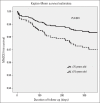Previous cerebrovascular disease is an important predictor of clinical outcomes in elderly patients with percutaneous coronary interventions: The Nobori-Biolimus eluting stent prospective multicenter 1-year observational registry in South Korea
- PMID: 28554989
- PMCID: PMC5731262
- DOI: 10.14744/AnatolJCardiol.2017.7670
Previous cerebrovascular disease is an important predictor of clinical outcomes in elderly patients with percutaneous coronary interventions: The Nobori-Biolimus eluting stent prospective multicenter 1-year observational registry in South Korea
Abstract
Objective: The appropriate selection of elderly patients for revascularization has become increasingly important because these subsets of patients are more likely to experience a major cardiac or cerebrovascular event-percutaneous coronary intervention (PCI). The objective of this study was to determine important independent risk factor for predicting clinical outcomes in the elderly patients after successful PCI, particularly in a series of South Korean population.
Methods: This study is prospective, multicenter, observational cross-sectional study. A total of 1,884 consecutive patients who underwent successful PCI with Nobori® Biolimus A9-eluting stents were enrolled between April 2010 and December 2012. They were divided into two groups according to the age: patients <75 years old (younger patient group) and ≥75 years old (elderly patient group). The primary endpoint was major adverse cardiac or cerebrovascular events (MACCE) at 1-year after index PCI.
Results: The 1-year cumulative incidence of MACCE (12.9% vs. 4.3%, p<0.001) and total death (7.1% vs. 1.5%, p<0.001) was significantly higher in the elderly group than in younger group. Previous cerebrovascular disease was significantly correlated with MACCE in elderly patients 1-year after PCI (hazard ratio, 2.804; 95% confidence interval, 1.290-6.093 p=0.009).
Conclusion: Previous cerebrovascular disease is important independent predictor of the MACCE in elderly patients at 1-year after PCI with Nobori® Biolimus A9-eluting stents especially in a series of South Korean population. Therefore, careful PCI with intensive monitoring and management can improve major clinical outcomes after successful PCI in elderly patients with previous cerebrovascular disease compared with younger patients.
Conflict of interest statement
Figures




Similar articles
-
Impact of 3-dimensional bifurcation angle on 5-year outcome of patients after percutaneous coronary intervention for left main coronary artery disease: a substudy of the SYNTAX trial (synergy between percutaneous coronary intervention with taxus and cardiac surgery).JACC Cardiovasc Interv. 2013 Dec;6(12):1250-60. doi: 10.1016/j.jcin.2013.08.009. JACC Cardiovasc Interv. 2013. PMID: 24355115 Clinical Trial.
-
2-year results of the AUTAX (Austrian Multivessel TAXUS-Stent) registry beyond the SYNTAX (synergy between percutaneous coronary intervention with TAXUS and cardiac surgery) study.JACC Cardiovasc Interv. 2009 Aug;2(8):718-27. doi: 10.1016/j.jcin.2009.05.019. JACC Cardiovasc Interv. 2009. PMID: 19695539 Clinical Trial.
-
Long-term clinical outcomes after percutaneous coronary intervention for ostial/mid-shaft lesions versus distal bifurcation lesions in unprotected left main coronary artery: the DELTA Registry (drug-eluting stent for left main coronary artery disease): a multicenter registry evaluating percutaneous coronary intervention versus coronary artery bypass grafting for left main treatment.JACC Cardiovasc Interv. 2013 Dec;6(12):1242-9. doi: 10.1016/j.jcin.2013.08.005. JACC Cardiovasc Interv. 2013. PMID: 24355114
-
The Role of Vascular Imaging in Guiding Routine Percutaneous Coronary Interventions: A Meta-Analysis of Bare Metal Stent and Drug-Eluting Stent Trials.Cardiovasc Ther. 2015 Dec;33(6):360-6. doi: 10.1111/1755-5922.12160. Cardiovasc Ther. 2015. PMID: 26363283 Review.
-
Percutaneous coronary intervention in the elderly.Nat Rev Cardiol. 2011 Feb;8(2):79-90. doi: 10.1038/nrcardio.2010.184. Epub 2010 Dec 7. Nat Rev Cardiol. 2011. PMID: 21139558 Review.
References
-
- Kung HC, Hoyert DL, Xu J, Murphy SL. Deaths: final data for 2005. Nat Vital Stat Rep. 2008;56:1–120. - PubMed
-
- Sandhu K, Nadar SK. Percutaneous coronary intervention in the elderly. Int J Cardiol. 2015;15:342–55. - PubMed
-
- Wennberg DE, Makenka DJ, Sengupta A, Lucas FL, Vaitkus PT, Quinton H, et al. Percutaneous transluminal coronary angioplasty in the elderly: epidemiology, clinical risk factors, and in-hospital outcomes. The Northern New England Cardiovascular Disease Study Group. Am Heart J. 1999;137:639–45. - PubMed
-
- Batchelor WB, Anstrom KJ, Muhlbaier LH, Grosswald R, Weintraub WS, O’Neill WW, et al. Contemporary outcome trends in the elderly undergoing percutaneous coronary interventions: results in 7,472 octogenarians. National Cardiovascular Network Collaboration. J Am Coll Cardiol. 2000;36:723–30. - PubMed
Publication types
MeSH terms
LinkOut - more resources
Full Text Sources
Other Literature Sources
Medical
Miscellaneous

